View in other NatureServe Network Field Guides
NatureServe
Montana
Utah
Wyoming
Idaho
Wisconsin
British Columbia
South Carolina
Yukon
California
New York
Gyrfalcon - Falco rusticolus
General Description
Several color phases, ranging from white to dark slate-gray, exist. White birds exhibit varying degrees of dark barring on the upper parts of the body, but the undersides may be nearly pure white. Darker birds have considerable dark barring and streaking on a light gray breast and belly. Gray birds are more commonly observed in Montana than white birds. Immature birds are similar to adults, but have blue-gray legs instead of the yellow legs of the adults. Females measure about 22 inches in length and have a wingspan of about 48 inches. Male measurements range from two to four inches smaller.
For a comprehensive review of the conservation status, habitat use, and ecology of this and other Montana bird species, please see
Marks et al. 2016, Birds of Montana.Diagnostic Characteristics
Gyrfalcons are much larger and appear stockier than either Peregrine or Prairie Falcons.
Species Range
Montana Range
Range Descriptions
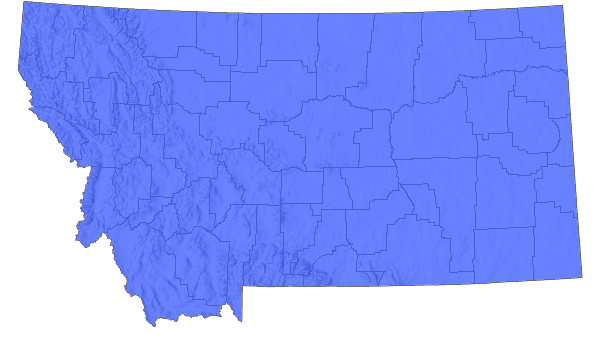 Western Hemisphere Range
Western Hemisphere Range
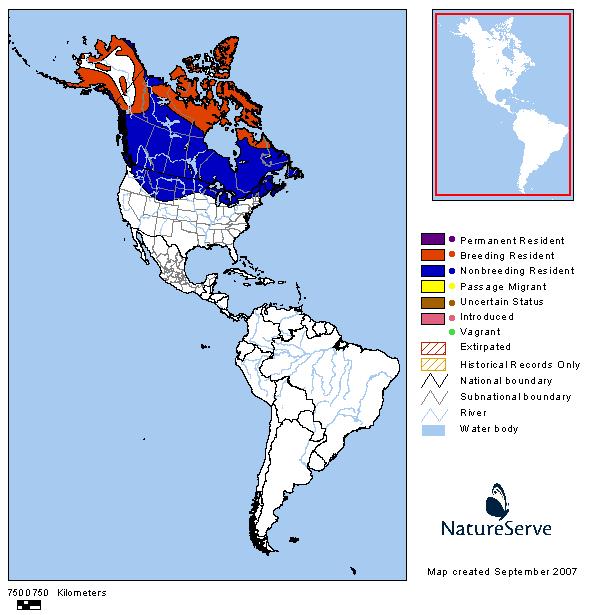
Observations in Montana Natural Heritage Program Database
Number of Observations: 331
(Click on the following maps and charts to see full sized version)
Map Help and Descriptions
Relative Density
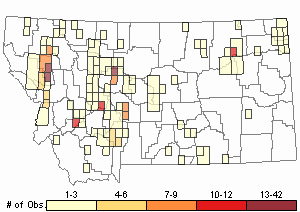
Recency
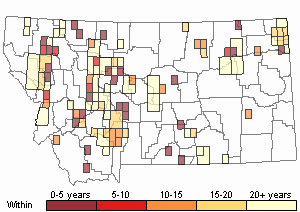
SUMMER (Feb 16 - Dec 14)
Direct Evidence of Breeding

Indirect Evidence of Breeding

No Evidence of Breeding

WINTER (Dec 15 - Feb 15)
Regularly Observed

Not Regularly Observed

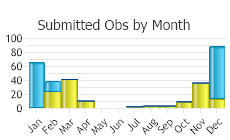
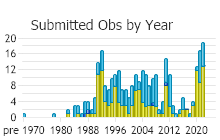
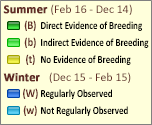 (Observations spanning multiple months or years are excluded from time charts)
(Observations spanning multiple months or years are excluded from time charts)
Migration
During years of prey shortages in the north, large numbers of Gyrfalcons move down into the northern United States in winter.
Habitat
Gyrfalcons breed in the remote Arctic and sub-Arctic zones around the globe. During the winter months, they often are seen as migrants or over-wintering birds in eastern Montana and in the western valleys, especially where waterfowl or upland game birds concentrate.
National Vegetation Classification System Groups Associated with this Species
Forest and Woodland
Deciduous Forest and Woodland
Low Elevation - Xeric Forest and Woodland
Shrubland
Arid - Saline Shrubland
Foothills - Montane Shrubland
Sagebrush Shrubland
Grassland
Lowland - Prairie Grassland
Sparse and Barren
Sparse and Barren
Wetland and Riparian
Alkaline - Saline Wetlands
Alpine Riparian and Wetland
Riparian and Wetland Forest
Riparian Shrubland
Wet Meadow and Marsh
Recently Disturbed or Modified
Introduced Vegetation
Human Land Use
Agriculture
Developed
Food Habits
Gyrfalcons primarily eat birds, ranging from small songbirds to ducks and grouse.
Ecology
Probably most records are of first year birds, that have not yet established breeding territories.
Reproductive Characteristics
Male Gyrfalcons begin defending their breeding territories as early as January and February, and females arrive by March. Eggs are laid by late April or early May, and young hatch after 30 to 35 days of incubation. The young fly when about seven to eight weeks old.
Stewardship Responsibility
References
- Literature Cited AboveLegend:
 View Online Publication
View Online Publication Marks, J.S., P. Hendricks, and D. Casey. 2016. Birds of Montana. Arrington, VA. Buteo Books. 659 pages.
Marks, J.S., P. Hendricks, and D. Casey. 2016. Birds of Montana. Arrington, VA. Buteo Books. 659 pages.
- Additional ReferencesLegend:
 View Online Publication
View Online Publication
Do you know of a citation we're missing? American Ornithologists’ Union [AOU]. 1998. Check-list of North American birds, 7th edition. American Ornithologists’ Union, Washington, D.C. 829 p.
American Ornithologists’ Union [AOU]. 1998. Check-list of North American birds, 7th edition. American Ornithologists’ Union, Washington, D.C. 829 p. Becker, Dale M., 1980, A Survey of raptors on national forest land in Carter County, Montana. Final Progress Report: 1977-1979.
Becker, Dale M., 1980, A Survey of raptors on national forest land in Carter County, Montana. Final Progress Report: 1977-1979. Beebe, F.L. 1974. Field studies of the Falconiformes of British Columbia. Occ. Paper Series, British Columbia Prov. Mus., No. 17. British Columbia Provincial Museum, Victoria. 163 pp.
Beebe, F.L. 1974. Field studies of the Falconiformes of British Columbia. Occ. Paper Series, British Columbia Prov. Mus., No. 17. British Columbia Provincial Museum, Victoria. 163 pp. Clum, N.J. and T.J. Cade. 1994. Gyrfalcon (Falco rusticolus). Species Account Number 114. The Birds of North America Online (A. Poole, Ed.). Ithaca, NY: Cornell Laboratory of Ornithology; Retrieved 3/25/2008 from The Birds of North America Online database
Clum, N.J. and T.J. Cade. 1994. Gyrfalcon (Falco rusticolus). Species Account Number 114. The Birds of North America Online (A. Poole, Ed.). Ithaca, NY: Cornell Laboratory of Ornithology; Retrieved 3/25/2008 from The Birds of North America Online database Decker Coal Co., 1981, Wildlife survey. July 7, 1981. In North Decker 5-Year Permit Application. Vol. III. Rule 26.4.304(12-14).
Decker Coal Co., 1981, Wildlife survey. July 7, 1981. In North Decker 5-Year Permit Application. Vol. III. Rule 26.4.304(12-14). DuBois, K. and D. Becker. 1987. Identification of Montana's birds of prey. Montana Outdoors Nov/Dec. 20 p.
DuBois, K. and D. Becker. 1987. Identification of Montana's birds of prey. Montana Outdoors Nov/Dec. 20 p. Ehrlich, P., D. Dobkin, and D. Wheye. 1988. The birder’s handbook: a field guide to the natural history of North American birds. Simon and Schuster Inc. New York. 785 pp.
Ehrlich, P., D. Dobkin, and D. Wheye. 1988. The birder’s handbook: a field guide to the natural history of North American birds. Simon and Schuster Inc. New York. 785 pp. Hays, R., R.L. Eng, and C.V. Davis (preparers). 1984. A list of Montana birds. Helena, MT: MT Dept. of Fish, Wildlife & Parks.
Hays, R., R.L. Eng, and C.V. Davis (preparers). 1984. A list of Montana birds. Helena, MT: MT Dept. of Fish, Wildlife & Parks. Hoffmann, R.S., R.L. Hand, and P.L. Wright. 1959. Recent bird records from western Montana. The Condor 61(2):147-151.
Hoffmann, R.S., R.L. Hand, and P.L. Wright. 1959. Recent bird records from western Montana. The Condor 61(2):147-151. Johnsgard, P.A. 1992. Birds of the Rocky Mountains with particular reference to national parks in the northern Rocky Mountain region. Lincoln: University of Nebraska Press. xi + 504 pp.
Johnsgard, P.A. 1992. Birds of the Rocky Mountains with particular reference to national parks in the northern Rocky Mountain region. Lincoln: University of Nebraska Press. xi + 504 pp. Joslin, Gayle, and Heidi B. Youmans. 1999. Effects of recreation on Rocky Mountain wildlife: a review for Montana. [Montana]: Montana Chapter of the Wildlife Society.
Joslin, Gayle, and Heidi B. Youmans. 1999. Effects of recreation on Rocky Mountain wildlife: a review for Montana. [Montana]: Montana Chapter of the Wildlife Society. Lenard, S., J. Carlson, J. Ellis, C. Jones, and C. Tilly. 2003. P. D. Skaar's Montana bird distribution, 6th edition. Montana Audubon, Helena, MT. 144 pp.
Lenard, S., J. Carlson, J. Ellis, C. Jones, and C. Tilly. 2003. P. D. Skaar's Montana bird distribution, 6th edition. Montana Audubon, Helena, MT. 144 pp. Lockhart, J. Michael, 1976, Effects of coal extraction and related development on wildlife populations. Annual progress report; Calendar year 1976. In Decker Coal Company West Pit Permit. Vol. 3. 26.4.304(10-11), 305, 306, and 307. Updated Rules Rewrite, July 1, 1991. Appendix F.
Lockhart, J. Michael, 1976, Effects of coal extraction and related development on wildlife populations. Annual progress report; Calendar year 1976. In Decker Coal Company West Pit Permit. Vol. 3. 26.4.304(10-11), 305, 306, and 307. Updated Rules Rewrite, July 1, 1991. Appendix F. Montana Bird Distribution Committee. 2012. P.D. Skaar's Montana bird distribution. 7th Edition. Montana Audubon, Helena, Montana. 208 pp. + foldout map.
Montana Bird Distribution Committee. 2012. P.D. Skaar's Montana bird distribution. 7th Edition. Montana Audubon, Helena, Montana. 208 pp. + foldout map. Oechsli, L.M. 2000. Ex-urban development in the Rocky Mountain West: consequences for native vegetation, wildlife diversity, and land-use planning in Big Sky, Montana. M.Sc. Thesis. Montana State University, Bozeman. 73 p.
Oechsli, L.M. 2000. Ex-urban development in the Rocky Mountain West: consequences for native vegetation, wildlife diversity, and land-use planning in Big Sky, Montana. M.Sc. Thesis. Montana State University, Bozeman. 73 p. Palmer, R. S., editor. 1988. Handbook of North American birds. Vol. 4. [Diurnal raptors, part 1]. Yale University Press, New Haven. vii + 433 pp.
Palmer, R. S., editor. 1988. Handbook of North American birds. Vol. 4. [Diurnal raptors, part 1]. Yale University Press, New Haven. vii + 433 pp. Salt, W.R. and J.R. Salt. 1976. The birds of Alberta. Hurtig Publishers, Edmonton, Alberta. xv + 498 pp.
Salt, W.R. and J.R. Salt. 1976. The birds of Alberta. Hurtig Publishers, Edmonton, Alberta. xv + 498 pp. Saunders, A.A. 1914. The birds of Teton and northern Lewis & Clark counties, Montana. Condor 16:124-144.
Saunders, A.A. 1914. The birds of Teton and northern Lewis & Clark counties, Montana. Condor 16:124-144. Sibley, D. 2014. The Sibley guide to birds. Alfred A. Knopf, New York, NY. 598 pp.
Sibley, D. 2014. The Sibley guide to birds. Alfred A. Knopf, New York, NY. 598 pp. Skaar, P. D., D. L. Flath, and L. S. Thompson. 1985. Montana bird distribution. Montana Academy of Sciences Monograph 3(44): ii-69.
Skaar, P. D., D. L. Flath, and L. S. Thompson. 1985. Montana bird distribution. Montana Academy of Sciences Monograph 3(44): ii-69. Skaar, P.D. 1969. Birds of the Bozeman latilong: a compilation of data concerning the birds which occur between 45 and 46 N. latitude and 111 and 112 W. longitude, with current lists for Idaho, Montana, Wyoming, impinging Montana counties and Yellowstone National Park. Bozeman, MT. 132 p.
Skaar, P.D. 1969. Birds of the Bozeman latilong: a compilation of data concerning the birds which occur between 45 and 46 N. latitude and 111 and 112 W. longitude, with current lists for Idaho, Montana, Wyoming, impinging Montana counties and Yellowstone National Park. Bozeman, MT. 132 p. Snow, C. 1974. Habitat management series for unique or endangered species, Report No. 9, Gyrfalcon Falco rusticolus L. Bureau of Land Management, U.S. Department of Interior, Technical Note, T-N-241, Denver.
Snow, C. 1974. Habitat management series for unique or endangered species, Report No. 9, Gyrfalcon Falco rusticolus L. Bureau of Land Management, U.S. Department of Interior, Technical Note, T-N-241, Denver. Taylor, D.M. and C.H. Trost. 1987. The status of historically rare of unrecorded birds in Idaho. Unpublished manuscript. 68 p.
Taylor, D.M. and C.H. Trost. 1987. The status of historically rare of unrecorded birds in Idaho. Unpublished manuscript. 68 p. Waldt, R. 1995. The Pine Butte Swamp Preserve bird list. Choteau, MT: The Nature Conservancy. Updated August 1995.
Waldt, R. 1995. The Pine Butte Swamp Preserve bird list. Choteau, MT: The Nature Conservancy. Updated August 1995. Watts, C.R. and L.C. Eichhorn. 1981. Changes in the birds of central Montana. Proceedings of the Montana Academy of Sciences 40:31-40.
Watts, C.R. and L.C. Eichhorn. 1981. Changes in the birds of central Montana. Proceedings of the Montana Academy of Sciences 40:31-40.
- Web Search Engines for Articles on "Gyrfalcon"
- Additional Sources of Information Related to "Birds"





